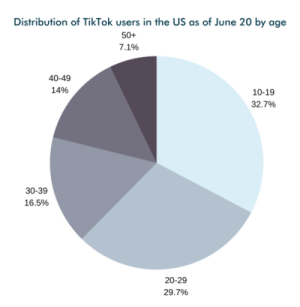The rise of TikTok has had a global impact on many levels - both from a user and a business perspective. Companies need to adapt quickly to keep up with accelerating changes in social networks and understand how they work to avoid being left behind. What counts now is the adoption of an agile and tailored approach that will allow companies to leverage social media networks and better anticipate future trends.
The rise of TikTok
What draws my attention to TikTok is likely different from the average user; its lightning-fast growth and staggering popularity make it interesting from an entrepreneurial perspective. ByteDance’s app went from 11 Million active users in 2018 to 700 Million in 2020 globally. In the US alone,TikTok’s monthly active users have grown by nearly 800% since January 2020. There are more than 100 Million American monthly users, and 50 million users daily.
Each month more professional producers join the ranks of TikTok’s viral dances, challenges and lip synching, posting the same humor-filled videos like the rest of them. Celebrities are now focusing their attention there and you’ll even find older generations, such as Dieter Bohlen ー a 66-year old veteran celeb known from the German-equivalent of America’s Got Talent ー fill his feed with comical videos. TikTok is slowly becoming the go-to for business promotion and PR, and is now attracting generations older than the original Gen Z audience.
Gen Z were the early adopters of TikTok and continue to be its main audience, but older generations like Millenials and Generation Y are taking notice.

Anyone who’s been on TikTok knows how addicting it is. It’s the crack of today’s social media that provides you with thousands of mesmerizing, binge-worthy video clips. Your feed is perfectly catered to you, thanks to ByteDance’s use of AI and its powerful algorithm (or “secret sauce” as it’s often called in the media). TikTok figured out the right approach to feed our need for instant gratification and addiction to social media.
Its rise in its popularity hasn’t gone completely unchallenged. The business saga of TikTok’s state of affairs in the US has been in the limelight these past weeks, and it changes nearly every day. The company is looking to sell its US-based operations or face a possible ban in the country. While negotiations of the sale are hyped in the news, there’s no doubt that TikTok will continue to be an important player in ecommerce.
Which stance should companies take?
TikTok also embodies the challenge that companies are now facing. With new networks popping up every quarter, they need to be quicker on their feet. With the likes of Instagram, TikTok, Likee, SnapChat, and more to come, Marketing teams have the task of juggling channels and keeping up with new trends. Ignoring them could place companies in real existential danger. Larger organizations need to wrap their heads around the accelerating trends of new networks to be two steps ahead, rather than behind.
How to stay ahead of the TikTok game
Making the most of social networks like TikTok is achieved by using an agile distribution platform that permits a much more manageable overview of new opportunities and changes in channels. Productsup in particular offers a platform that combines feed management, product content syndication and marketplace integration. Businesses can syndicate content to digital marketing and business channels, including Facebook and Instagram.
Another critical point is understanding the specific voice that should be used for each of your audiences. One-size-fits-all content for all channels is no way near as effective than the micro-brand approach. If you’ve spent any time on Instagram, you’ll notice that your Feed or Stories are filled with ads from smaller companies. These brands have managed to leverage social networks and by doing so, have become competitors to bigger, more established companies. They’ve understood how to tailor their communication and content style, which is proven better for converting social media users into clients.
Social commerce predictions for better business planning
Influencer marketing will continue to grow
Now would also be a good time to start recruiting popular or up-and-coming influencers on TikTok. The principle works the same as on Instagram; they produce credible content and promote products that fit their own personal brand. They drive sales by giving out promo codes to their followers to get discounts on the featured product. The difference is that the pace is so much faster than on Instagram or YouTube. Influencers will have to find clever ways to show the product in a much shorter time frame.
Some ideas to get around this would be to use trends that already work on TikTok, such as challenges. For example, the influencer could create a branded challenge and use a dedicated hashtag.The goal would be get the hashtag trending on the Discovery page.
Social network market checkouts a sure bet
Short-sided views will only get you so far. It’s also important to consider what events will unfold in the future and make educated guesses about what will come next. On the short-term, it’s safe to presume that all of these emerging social network apps will offer native checkout capabilities. Facebook has already incorporated this within the Instagram app, and it’s likely to happen for SnapChat, Likee, and TikTok. Usually, once one of the players has shown that an idea works, the rest launch their own version.
In turn, companies will need to accommodate these changes - the complexity of integrating with each of these platforms and properly managing them are hurdles that companies will have to perfectly overcome.
A new ad platform for TikTok
Currently TikTok doesn’t have an ad platform that companies can integrate with, but if we’ve learned anything from the success of Facebook Dynamic Ads or SnapChat Ads, it’s highly probable that this feature will come sooner or later. Companies need to get ready prior to when that moment comes and work on building up their following, and understanding exactly how they can best engage with their audiences.
Likee continues to gain traction
While TikTok’s American ban or sale is still on the table, there’s a new rising star in the social media galaxy. Likee is a Singapore-based short video creation and sharing platform, similar to TikTok, that’s achieved staggering recent growth; as of June 2020 it clocked 150 million monthly active users.
Likee offers some additional features that TikTok does not. It allows influencers to make money from virtual gifts they receive from fans. This could open up new sponsoring opportunities for producers. For example, you could give virtual Nike sneakers to an influencer that you like, who can show it off on their digital shelf - simple tactics like this could give companies additional exposure.
Instagram’s Reels will run in parallel to TikTok
Instagram recently launched Reels, a feature that heavily imitates TikTok’s user-made videos. Many were dubious about the introduction of Reels and whether it would draw users away from TikTok. I believe that Reels does have a chance, but only for Instagram audiences specifically. It won’t entice content creators away from TikTok in any significant way. Instagram users will enjoy the functionality of Reels, which will work towards increasing Instagram’s retention and making people spend more hours in the app. It will further fuel the rise in popularity of Instagram Stories, which now sees more than 500 million daily users.
Social commerce mistakes to avoid
Catering to audiences on social media is usually a topic of interest for Marketing teams, but they need to re-evaluate how they are creating content specifically for each of them, as mentioned above.
Secondly, companies need to do more in the way of community management. The one-way-street approach of sending out ads without thinking about the response and sentiments can be very damaging to a brand. There are plenty of examples in the news of companies who committed a faux-pas that had negative effects. An example that comes to mind is the Kendel Jenner Pepsi commercial. Engaging proactively in the different types of conversations happening in online communities provides many learning opportunities - decisive business conclusions can be drawn just like in any type of feedback loop.
Social commerce isn’t just for lifestyle and fashion retailers
TikTok, Likee, and other popular social media networks are not just for fashion, lifestyle and sport-type brands, everyone needs to get on board. Garnering a social presence is a way to make any brand more approachable. Whether you’re a hardware store, plumber or IT company, social media should be prioritized. By adding personality to your brand, you increase trust, which is a proven factor that drives customers to commit to a purchase. For example, the hardware store can publish DIY videos, a generally very engaging type of content, like in the case of the German company, Hornbach.
Another question that I often get asked is whether social media is also for B2B. Today’s consumers are spoiled by the user experiences they get from the likes of Facebook and Google, and the buying experience from Amazon and Zalando. Any type of buyer will expect the same user journey. B2B companies should also invest in creating a positive social experience that ties into their commercial setup.
Taking social commerce by the horns
With the continued growth of TikTok and Likee, and the emergence of new networks every three months, social commerce will stay on course in an upward trajectory. It’s driven by new features like in-app marketplaces, the predicted TikTok ads, and easily digestible and addictive video content. Companies need to tune into these channels to gain important insights and adapt to a faster pace that I can only see quickening.

